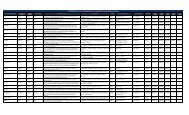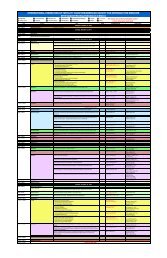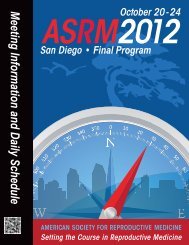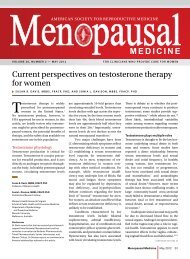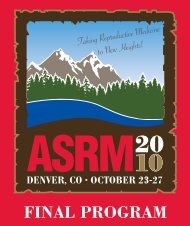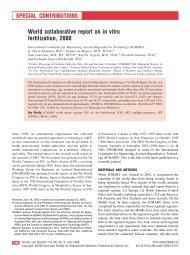scientific program • symposia - American Society for Reproductive ...
scientific program • symposia - American Society for Reproductive ...
scientific program • symposia - American Society for Reproductive ...
You also want an ePaper? Increase the reach of your titles
YUMPU automatically turns print PDFs into web optimized ePapers that Google loves.
44 TH ANNUAL POSTGRADUATE PROGRAM<br />
and spermatgonial stem cell culture/cryopreservation now and in the future; adolescent and adult barriers to fertility<br />
preservation and stategies to overcome them; techniques of semen, testis tissue, and stem cell cryopreservation; when<br />
and how best to use sperm that has returned to the ejaculate after therapy or from a frozen sample; who else may be<br />
appropriate <strong>for</strong> fertility preservation strategies; and setting up a fertility preservation <strong>program</strong>.<br />
LEARNING OBJECTIVES<br />
After participating in this course, participants should be able to:<br />
1. Summarize the scope of the need <strong>for</strong> male fertility and reproductive preservation.<br />
2. Describe the present-day role and techniques of testis tissue extraction in the care of the prepubertal oncology patient<br />
and the future use of spermatogonial stem cells.<br />
3. Explain the present-day role, complexities of and barriers to semen and tissue cryopreservation in the adolescent and<br />
adult oncology patient.<br />
4. Appraise the various methods of semen and tissue cryopreservation.<br />
5. Assess the potential need <strong>for</strong> reproductive preservation in other populations of males, including those with Klinefelter<br />
syndrome, spinal cord injuries and other debilitating diseases.<br />
6. Formulate plans <strong>for</strong> establishment of a fertility preservation <strong>program</strong> or linkage to one already in existence.<br />
________________________________________________________________________________________________________________________<br />
LEGAL, MEDICAL AND ETHICAL ISSUES OF OOCYTE DONATION AND GESTATIONAL SURROGACY<br />
Course PG16 (Sunday) <strong>•</strong> ROOM 330 A/D CME<br />
Developed in Cooperation with the <strong>Society</strong> <strong>for</strong> Assisted <strong>Reproductive</strong> Technology<br />
FACULTY<br />
James Goldfarb, M.D., M.B.A., Chair<br />
Susan L. Crockin, J.D.<br />
Ruth M. Farrell, M.D., M.A.<br />
William E. Gibbons, M.D.<br />
ACGME COMPETENCY<br />
Patient Care<br />
NEEDS ASSESSMENT AND COURSE DESCRIPTION<br />
Third-party reproduction, particularly oocyte donation (OD) and gestational surrogacy (GS), has received much<br />
professional and public attention. Both of these procedures have been utilized since the mid 1980s, but as they have<br />
evolved, the medical, legal and ethical complexities have increased greatly. It is imperative that individuals involved with<br />
these procedures be aware of the current medical, ethical and legal issues associated with these procedures.<br />
Aimed at physicians, psychologists, nurses and social workers whose practices may include patients considering<br />
third-party reproduction, this course will address current issues in gestational surrogacy from medical, ethical and legal<br />
standpoints. Cases will be presented, and current legislation will also be reviewed.<br />
LEARNING OBJECTIVES<br />
After participating in this course, participants should be able to:<br />
1. Summarize the medical, legal and ethical issues regarding OD and GS.<br />
2. List the guidelines <strong>for</strong> payment of egg donors.<br />
3. Discuss the legal issues, particularly in regard to gestational surrogacy and state regulation of third-party reproduction.<br />
4. List the pros and cons of establishment of a national egg donor registry.<br />
5. Explain the differences between anonymous and directed egg donation.<br />
6. Assess the current status of cross-border reproductive care as it relates to OD and GS.<br />
________________________________________________________________________________________________________________________<br />
Developed in Cooperation with the Endometriosis Special Interest Group<br />
FACULTY<br />
Tommaso Falcone, M.D., Chair<br />
Dan I. Lebovic, M.D.<br />
Kathy L. Sharpe-Timms, Ph.D., H.C.L.D.<br />
Pamela Stratton, M.D.<br />
ACGME COMPETENCY<br />
Patient Care<br />
ENDOMETRIOSIS: THE LINK BETWEEN PATHOPHYSIOLOGY AND TREATMENT<br />
Course PG17 (Sunday) <strong>•</strong> ROOM 224 E/F CME<br />
51



